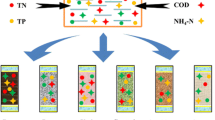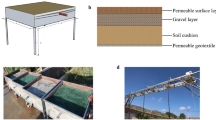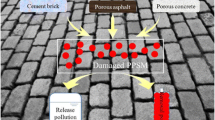Abstract
Permeable pavement is an effective means for stormwater runoff control and pollutant removal. However, relatively few studies have examined the characteristics of permeable brick and corresponding permeable pavement system (PPS). In this work, the permeable pavement systems consisted of surface permeable brick layer (concrete or ceramic) with structural layer (including a cement mortar layer, a permeable concrete layer, and a gravel layers) were selected as typical cases to assess their permeability and runoff pollutant removal performance by laboratory experiments. The results indicated that PPS had obvious outflow hysteresis effect. The PPS with ceramic brick layer reached the saturation flow rate earlier and showed larger outflow rate than that with concrete brick layer. Both types of PPSs had a relatively high efficiency (83.8–95.2%) in removing suspended solids (SS) in stormwater runoff mainly due to the interception and filtration of the surface brick layer, whereas the structural layer of the PPS played a vital role in the removal of total phosphorus (TP). The percentage of total nitrogen (TN) removal efficiency via ceramic brick layer accounted for via corresponding PPS was obviously larger than that of concrete brick layer. The PPS also displayed a certain chemical oxygen demand (COD) removal ability: around 14.0–27.0% for concrete type and 20.9–28.9% for ceramic type. Subsequently, a multi-objective evaluation model was implemented based on the analytic hierarchy process (AHP) method to identify the optimal scheme in relation to four indices: permeability, environmental benefit, compressive strength, and comprehensive economic cost. The results showed, insofar, the ceramic PPS is preferred with a better economic performance. Our study attempts to select optimal designs of PPS and provides insight into the permeable capacity and the efficiency of pollutant removal in PPS.










Similar content being viewed by others
Data availability
The datasets used and analyzed during the current study are available from the corresponding author on reasonable request.
References
Alam T, Mahmoud A, Jones KD, Bezares-Cruz JC, Guerrero J (2019) A comparison of three types of permeable pavements for urban runoff mitigation in the semi-arid South Texas. U.S.A. Water (Switzerland) 11(10):1–23. https://doi.org/10.3390/w11101992
Aydi A, Zairi M, Ben H (2013) Minimization of environmental risk of landfill site using fuzzy logic, analytical hierarchy process, and weighted linear combination methodology in a geographic information system environment. Environ Earth Sci 1375–1389. https://doi.org/10.1007/s12665-012-1836-3
Ayu IW, Prijono S (2013) Assessment of infiltration rate under different drylands types in Unter-Iwes Subdistrict Sumbawa Besar, Indonesia. J Nat Sci Res 3(10):2225–2921
Badri MA (1999) Combining the analytic hierarchy process and goal programming for global facility location-allocation problem. Int J Prod Econ 62(3):237–248. https://doi.org/10.1016/S0925-5273(98)00249-7
Balades J, Legret M, Madiec H (1995) Permeable pavements: pollution management tools. Water Sci Technol 32(1):49–56. https://doi.org/10.1017/CBO9781107415324.004
Bean EZ, Hunt WF, Bidelspach DA (2007) Evaluation of four permeable pavement sites in Eastern North Carolina for runoff reduction and water quality impacts. J Irrig Drain Eng 133(6):583–592. https://doi.org/10.1061/(ASCE)0733-9437(2007)133:6(583)
Brezonik PL, Stadelmann TH (2002) Analysis and predictive models of stormwater runoff volumes, loads, and pollutant concentrations from watersheds in the Twin Cities metropolitan area, Minnesota, USA. Water Res 36(7):1743–1757. https://doi.org/10.1016/S0043-1354(01)00375-X
Brown C, Chu A, Duin B, Valeo C (2009) Characteristics of sediment removal in two types of permeable pavement. Water Qual Res J Can 44(1):59–70. https://doi.org/10.2166/wqrj.2009.007
Chandrappa AK, Biligiri KP (2016) Pervious concrete as a sustainable pavement material-Research findings and future prospects: a state-of-the-art review. Constr Build Mater 111:262–274. https://doi.org/10.1016/j.conbuildmat.2016.02.054
Cueto-Felgueroso L, Juanes R (2009) Stability analysis of a phase-field model of gravity-driven unsaturated flow through porous media. Phys Rev E Stat Nonlinear Soft Matter Phys 79(3):44–47. https://doi.org/10.1103/PhysRevE.79.036301
Dicarlo DA (2013) Stability of gravity-driven multiphase flow in porous media: 40 Years of advancements. Water Resour Res 49(8):4531–4544. https://doi.org/10.1002/wrcr.20359
Dietz ME (2007) Low impact development practices: a review of current research and recommendations for future directions. Water Air Soil Pollut 186(1–4):351–363. https://doi.org/10.1007/s11270-007-9484-z
Eck BJ, Asce M, Winston RJ, Asce AM, Hunt WF, Asce M (2012) Water quality of drainage from permeable friction course. (February) 174–181. https://doi.org/10.1061/(ASCE)EE.1943-7870.0000476
Fach S, Geiger WF (2005) Effective pollutant retention capacity of permeable pavements for infiltrated road runoffs determined by laboratory tests. Water Sci Technol 51(2):37–45. https://doi.org/10.2166/wst.2005.0030
Flekkøy EG, Schmittbuhl J, Løvholt F, Oxaal U, Jørgen Måløy K, Aagaard P (2002) Flow paths in wetting unsaturated flow: experiments and simulations. Phys Rev E Stat Phys Plasmas Fluids Relat Interdiscip Topics 65(3):1–9. https://doi.org/10.1103/PhysRevE.65.036312
Giri S, Nejadhashemi AP (2014) Application of analytical hierarchy process for effective selection of agricultural best management practices. J Environ Manag 132:165–177. https://doi.org/10.1016/j.jenvman.2013.10.021
Gnecco I, Berretta C, Lanza LG, Barbera PL (2005) Storm water pollution in the urban environment of Genoa, Italy. Atmospheric Research 77(1-4 SPEC. ISS.): 60–73. https://doi.org/10.1016/j.atmosres.2004.10.017
Grzmil B, Wronkowski J (2006) Removal of phosphates and fluorides from industrial wastewater. Desalination 189(1-3 SPEC. ISS.): 261–268. https://doi.org/10.1016/j.desal.2005.07.008
Han S, Yang Y, Liu S, Lu M (2020) Decontamination performance and cleaning characteristics of three common used paved permeable bricks. Environ Sci Pollut Res. https://doi.org/10.1007/s11356-020-11706-y
Hu J, Qian Z, Liu P, Wang D, Oeser M (2020) Investigation on the permeability of porous asphalt concrete based on microstructure analysis. Int J Pavement Eng 21(13):1683–1693. https://doi.org/10.1080/10298436.2018.1563785
Jang W, Sha A, Xiao J, Pei J (2013) Model and efficiency of permeable asphalt pavement. J Tongji Univ (Nat Sci Ed) 41(01):72–77 (in Chinese)
Jiang W, Sha A, Xiao J, Li Y, Huang Y (2015) Experimental study on filtration effect and mechanism of pavement runoff in permeable asphalt pavement. Constr Build Mater 100:102–110. https://doi.org/10.1016/j.conbuildmat.2015.09.055
Jiang C, Li J, Li H, Li Y (2019) An improved approach to design bioretention system media. Ecol Eng 136(June):125–133. https://doi.org/10.1016/j.ecoleng.2019.06.014
Kamali M, Delkash M, Tajrishy M (2017) Evaluation of permeable pavement responses to urban surface runoff. J Environ Manag 187:43–53. https://doi.org/10.1016/j.jenvman.2016.11.027
Karimi AR, Mehrdadi N, Hashemian SJ, Bidhendi GRN, Moghaddam RT (2011) Selection of wastewater treatment process based on the analytical hierarchy process and fuzzy analytical hierarchy process methods 8(2): 267–280
Khoshand A, Kamalan H, Rezaei H (2018) Application of analytical hierarchy process (AHP) to assess options of energy recovery from municipal solid waste: a case study in Tehran. J Mater Cycles Waste Manag 20(3):1689–1700. https://doi.org/10.1007/s10163-018-0736-3
Kia A, Wong HS, Cheeseman CR (2017) Clogging in permeable concrete: a review. J Environ Manag 193:221–233. https://doi.org/10.1016/j.jenvman.2017.02.018
Kim RH, Jeong J, Lee S, Gee CS (2006) Estimation of environment-friendly permeable pavement at laboratory test. Mater Sci Forum 510–511:914–917. https://doi.org/10.4028/www.scientific.net/msf.510-511.914
Kuruppu U, Rahman A, Rahman MA (2019) Permeable pavement as a stormwater best management practice: a review and discussion. Environ Earth Sci 78(10):1–20. https://doi.org/10.1007/s12665-019-8312-2
Li H, Harvey J, Ge Z (2014) Experimental investigation on evaporation rate for enhancing evaporative cooling effect of permeable pavement materials. Constr Build Mater 65:367–375. https://doi.org/10.1016/j.conbuildmat.2014.05.004
Li H, Li Z, Zhang X, Li Z, Liu D, Li T, Zhang Z (2017) The effect of different surface materials on runoff quality in permeable pavement systems. Environ Sci Pollut Res 24(26):21103–21110. https://doi.org/10.1007/s11356-017-9750-6
Lin Z, Yang H, Chen H, Ouyang X, Liu Z (2020) Comparison of the decontamination performance of three permeable bricks: adsorption and filtration experiments. Pol J Environ Stud 29(5):3225–3233. https://doi.org/10.15244/pjoes/114262
Liu XP (2008) Study on the water-effects of unsaturated-soil roadbed and water-transfer characteristics in the roadbed. Dissertation, Hunan University (in Chinese)
Liu J, Yan H, Liao Z, Zhang K, Schmidt AR, Tao T (2019) Laboratory analysis on the surface runoff pollution reduction performance of permeable pavements. Sci Total Environ 691:1–8. https://doi.org/10.1016/j.scitotenv.2019.07.028
Lv G, Hao XY (2008) Review on influential factors of soil infiltration characteristics. Chin Agric Sci Bull 24:494–499 (in Chinese)
Miao ZT, Han M, Hashemi S (2019) The effect of successive low-impact development rainwater systems on peak flow reduction in residential areas of Shizhuang, China. Environ Earth Sci 78(2):1–12. https://doi.org/10.1007/s12665-018-8016-z
MOHURD (2009) Technical specification for pervious cement concrete pavement (CJJ/T135-2009). People’s Republic of China Industry Standard, 1–45 (in Chinese)
MOHURD (2012) Technical specification for pavement of water permeable brick (CJJ/T 188-2012). China Building Industry Press, pp 1–44 (in Chinese)
MOHURD (2019) Ningbo urban planning and design guideline for sponge city. Implementation Rules for Residential Buildings Design in Ningbo, 1–72 (in Chinese). http://zjw.ningbo.gov.cn/art/2020/6/3/art_1229126811_58917833.html. Accessed 3 Jun 2020
NDRC (2005) Water Permeable Brick(JC/T945-2005). Standards for Building Materials Industry of the People’s Republic of China, 1–12 (in Chinese)
Niu ZG, Lv ZW, Zhang Y, Cui ZZ (2016) Stormwater infiltration and surface runoff pollution reduction performance of permeable pavement layers. Environ Sci Pollut Res 23(3):2576–2587. https://doi.org/10.1007/s11356-015-5466-7
Nnadi EO, Coupe SJ, Sañudo-Fontaneda LA, Rodriguez-Hernandez J (2014) An evaluation of enhanced geotextile layer in permeable pavement to improve stormwater infiltration and attenuation. Int J Pavement Eng 15(10):925–932. https://doi.org/10.1080/10298436.2014.893325
Pal AC, Das SS (2019) Interlocking aperture concrete block: an answer to permeable pavement. J Inst Eng (India): Ser A 100(3):427–438. https://doi.org/10.1007/s40030-019-00363-1
Park JY, Byun H, Choi WH, Kang WH (2008) Cement paste column for simultaneous removal of fluoride, phosphate, and nitrate in acidic wastewater. Chemosphere 70(8):1429–1437. https://doi.org/10.1016/j.chemosphere.2007.09.012
Roseen RM, Ballestero TP, Houle JJ, Briggs JF, Houle KM (2012) Water quality and hydrologic performance of a porous asphalt pavement as a storm-water treatment strategy in a cold climate. J Environ Eng 138(1):81–89. https://doi.org/10.1061/(ASCE)EE.1943-7870.0000459
Saaty TL (1990) How to make a decision: the analytic hierarchy process. Eur J Oper Res 48(1):9–26. https://doi.org/10.1016/0377-2217(90)90057-I
Sañudo-Fontaneda LA, Rodriguez-Hernandez J, Vega-Zamanillo A, Castro-Fresno D (2013) Laboratory analysis of the infiltration capacity of interlocking concrete block pavements in car parks. Water Sci Technol 67(3):675–681. https://doi.org/10.2166/wst.2012.614
Sañudo-Fontaneda LA, Charlesworth SM, Castro-Fresno D, Andres-Valeri VCA, Rodriguez-Hernandez J (2014) Water quality and quantity assessment of pervious pavements performance in experimental car park areas. Water Sci Technol 69(7):1526–1533. https://doi.org/10.2166/wst.2014.056
Schlea D, Martin JF, Ward AD, Brown LC, Suter SA (2014) Performance and water table responses of retrofit rain gardens. J Hydrol Eng 19(8):05014002. https://doi.org/10.1061/(asce)he.1943-5584.0000797
Scholz M, Grabowiecki P (2007) Review of permeable pavement systems. Build Environ 42(11):3830–3836. https://doi.org/10.1016/j.buildenv.2006.11.016
SEPA (1989a) GB 11893-89: Water quality-determination of total phosphorus-ammonium molybdate spectrophotometric method. (in Chinese)
SEPA (1989b) GB 11894-89: Water quality-determination of total nitrogen-alkaline potassium persulfate digestion-UV spectrophotometric method. (in Chinese)
SEPA (1989c) GB 11901-89: Water quality-determination of suspended substance-gravimetric method. (in Chinese)
SEPA (1989d) GB 11914-89: Water quality-determination of the chemical oxyzen demand-dichromate method. (in Chinese)
Soetardji JP, Claudia JC, Ju YH, Hriljac JA, Chen TY, Soetaredjo FE, Ismadji S (2015) Ammonia removal from water using sodium hydroxide modified zeolite mordenite. RSC Adv 5(102):83689–83699. https://doi.org/10.1039/c5ra15419g
Song R, Gong Y, Li J, Li X (2014) Progress in controlling urban non-point source pollution bypermeable pavement. Environ Sci Technol 37(05):57–63
Tota-Maharaj K, Scholz M (2010) Efficiency of Permeable Pavement Systems for the Removal of Urban Runoff Pollutants Under Varying Environmental Conditions Kiran. Environ Prog Sustain Energy 33(3):676–680. https://doi.org/10.1002/ep.10418
Vaidya OS, Kumar S (2006) Analytic hierarchy process: an overview of applications. Eur J Oper Res 169(1):1–29. https://doi.org/10.1016/j.ejor.2004.04.028
Wang Z, Xie J, Xie Q, Lai L, Wu D (2013) Research progress on purification of urban rainwater runoff by permeable pavement ground impounding. Environ Sci Technol 36(S2):138–143 (in Chinese)
Wang J, Song J, Zhang Y, Zhang Y, Li JQ (2016) Experiment of controlling runoff pollutant by permeable concrete pavement with permeable pipe. Water Treat Technol 42(03):111–115 (in Chinese)
Wang J, Zhang H, Wei S, Zhang Y, Feng C, Li JQ (2017) Experimental study on runoff and pollutant reduction conducted by pervious concrete pavementunder extreme rainfall. Environ Eng 35(02):28–32 (in Chinese)
Xie N, Akin M, Shi X (2019) Permeable concrete pavements: a review of environmental benefits and durability. J Clean Prod 210:1605–1621. https://doi.org/10.1016/j.jclepro.2018.11.134
Yang D, Wang W, Li K, Chen W, Yang J, Wang S (2019) Experimental investigation on the stress sensitivity of permeability in naturally fractured shale. Environ Earth Sci 0(0), 0. https://doi.org/10.1007/s12665-019-8045-2
Yuan X, Tang Y, Li Y, Wang Q, Zuo J, Song Z (2018) Environmental and economic impacts assessment of concrete pavement brick and permeable brick production process - a case study in China. J Clean Prod 171:198–208. https://doi.org/10.1016/j.jclepro.2017.10.037
Zhang J, White D, Taylor PC, Shi C (2015) A case study of evaluating joint performance in relation with subsurface permeability in cold weather region. Cold Reg Sci Technol 110:19–25. https://doi.org/10.1016/j.coldregions.2014.11.003
Zhang Z, Li Z, Zhang X, Liu D, Li Z, Li H (2018) Systematically investigated the influences of permeable pavement materials on the water quality of runoff: batch and column experiments. Water, Air, Soil Pollut 229(5). https://doi.org/10.1007/s11270-018-3772-7
Zhejiang Provincial Department of Housing and Urban-Rural Development (2020) Standards for rainfall intensity computation (DB33/T1191-2020). http://jst.zj.gov.cn/art/2020/3/6/art_1228990170_208.html. Accessed 6 Mar 2020
Funding
The study was sponsored by Ningbo Housing and Urban-Rural Development Bureau (HK2019000028), the Key Research and Development Program of Zhejiang Province (2020C03082) and K.C. Wong Magna Fund in Ningbo University.
Author information
Authors and Affiliations
Contributions
HG and ZY conceived and designed the experiments and wrote the article. ZY, MX, BH, ZZ, YL, HW performed the experiments, collected and analyzed the data. DZ and HG involved in conceptualization, supervision and writing. All authors contributed to the general discussion.
Corresponding author
Ethics declarations
Ethics approval and consent to participate
Not applicable
Consent for publication
Not applicable
Competing interests
The authors declare that they have no competing interests.
Additional information
Responsible editor: Philippe Garrigues
Publisher’s note
Springer Nature remains neutral with regard to jurisdictional claims in published maps and institutional affiliations.
Rights and permissions
About this article
Cite this article
Yu, Z., Gan, H., Xiao, M. et al. Performance of permeable pavement systems on stormwater permeability and pollutant removal. Environ Sci Pollut Res 28, 28571–28584 (2021). https://doi.org/10.1007/s11356-021-12525-5
Received:
Accepted:
Published:
Issue Date:
DOI: https://doi.org/10.1007/s11356-021-12525-5




